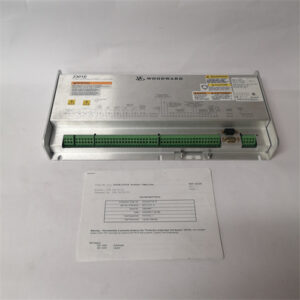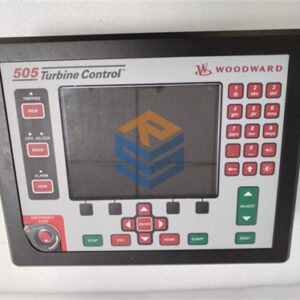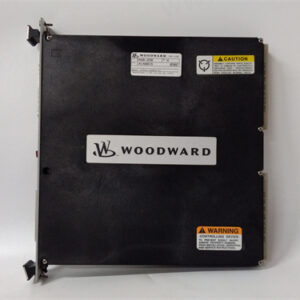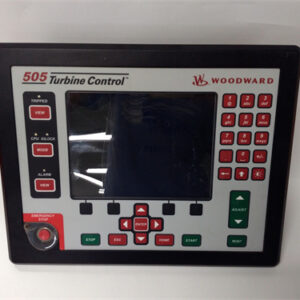الوصف
WOODWARD 9907-1350: Mechanical-Hydraulic Speed Droop Governor (TG-17E, Electrical Speed Setting)
The WOODWARD 9907-1350 is a self-contained, robust control device that plays a crucial role in the reliable operation of small to medium-sized steam turbines. Unlike the “L” (Lever) or “S” (Screw) versions of the TG series, the “E” in TG-17E indicates that its speed setpoint is adjusted electrically, offering more flexibility for remote control and integration into larger control systems. These governors are generally used where isochronous (constant speed) operation is not required, and a slight speed droop with increasing load is acceptable for system stability.
Product Overview
The 9907-1350 operates as a mechanical-hydraulic governor, continuously sensing the turbine’s rotational speed. It then compares this speed to an electrically set internal speed setpoint. Based on this comparison, it precisely adjusts the turbine’s governor valve to regulate the steam inlet flow, thereby controlling the turbine’s speed.
- Product Type: Mechanical-Hydraulic Speed Droop Governor
- Manufacturer: Woodward
- Series: TG-17E (Electrical Speed Setting)
- Application: Small to medium steam turbines (e.g., driving pumps, compressors, generators).
- Key Feature: Speed droop control (not isochronous).
- Speed Setting Mechanism: Electrical (allowing for remote or automatic speed adjustments).
- Output: 23.7 N·m (17.5 ft-lb) rotary output. (The TG-17 series provides higher work output than the TG-13 series).
- Environmental Certification: Often ATEX certified (suitable for potentially explosive atmospheres), depending on the specific model variant. Woodward TG governors are designed for harsh environments.
Detailed Product Description
The WOODWARD 9907-1350 provides a robust and adaptable solution for steam turbine speed control. As part of the TG-17E series, it combines the reliability of mechanical-hydraulic operation with the convenience of electrical speed adjustment.
Here’s a breakdown of its features and how it functions:
- Mechanical-Hydraulic Operation: This governor is a self-contained unit. It uses an integrated drive shaft-driven ball head assembly to accurately sense the turbine’s speed. An internal, shaft-driven oil pump generates the necessary hydraulic pressure (1379 kPa / 200 psi for TG-17 governors, which is higher than the TG-13’s 1034 kPa / 150 psi) to power the internal servomotor. This servomotor then precisely controls the turbine’s steam admission valve. This robust mechanical-hydraulic design minimizes reliance on external electronic components for its core speed sensing and actuation.
- Speed Droop Control: The 9907-1350 operates on the speed droop principle. This means that as the load on the turbine increases, its speed will slightly decrease proportionally. This characteristic is often desired in applications involving load sharing among multiple prime movers (like generators operating in parallel) or where a slight, predictable speed variation due to load changes is acceptable for system stability. The droop is internally adjustable and factory set at 6% for 20° terminal shaft travel at common rated speeds.
- Direct Turbine Connection: The governor is designed for direct coupling to the steam turbine’s rotor or an auxiliary shaft to receive speed input. Its rotary output shaft then directly connects to the turbine’s steam admission valve, enabling precise regulation of steam flow. The output (terminal) shaft typically extends out both sides of the case.
- Electrical Speed Setting (“E” in TG-17E): This is a key differentiator for the 9907-1350. Instead of a physical lever or screw, the speed setpoint is adjusted electrically. This allows for:
- Remote speed adjustment: Operators can change the turbine speed from a control room.
- Automated control: The governor can receive speed setpoint signals from a plant’s Distributed Control System (DCS) or other higher-level controllers.
- Precise setting: Electrical inputs can often provide finer resolution for speed adjustments.
- High Work Output: As a TG-17 series governor, it provides a substantial work output of 23.7 N·m (17.5 ft-lb). This increased capacity allows it to control larger or more demanding turbine valves compared to the TG-13 series governors.
- Rugged Construction and Certifications: Built to withstand demanding industrial environments, these governors feature robust, weatherproof construction and a self-contained oil sump to reduce contamination. Many TG-17E models, including this one, are ATEX certified, making them suitable for installation in potentially explosive atmospheres in compliance with European directives.
Technical Specifications (General)
While the exact rated speed for the 9907-1350 isn’t explicitly listed in available general documentation without a specific datasheet for that part number, TG-17E governors generally fall within the broad TG-17 speed ranges (e.g., 1100–2400 rpm, 2400–4000 rpm, 4000–6000 rpm). The “E” designation primarily changes the speed setting method.
Typical Applications
The WOODWARD 9907-1350 is commonly used in industrial settings that employ small to medium steam turbines for mechanical drive or power generation, particularly in scenarios where:
- Remote or Automated Speed Control is Required: This is the primary advantage of the “E” (Electrical) version, allowing integration with modern control systems.
- Higher Work Output is Needed: To operate larger or stiffer turbine control valves effectively.
- Speed Droop Control is Adequate: For applications where stable load sharing or predictable speed variation with load changes is acceptable.
- Robust Mechanical-Hydraulic Control is Preferred: Despite the electrical speed setting, the core governor remains a highly reliable mechanical-hydraulic unit, often preferred for its durability in harsh environments and inherent fail-safe characteristics.
- Hazardous Environments: ATEX certification makes it suitable for use in industries like oil & gas, petrochemical, and power generation where explosive atmospheres may exist.
Common use cases include controlling steam turbines that drive:
- Various process pumps.
- Compressors and turboexpanders in industrial plants.
- Generators for power generation, especially when operating in parallel with other power sources and requiring remote setpoint changes.
- Large industrial fans.

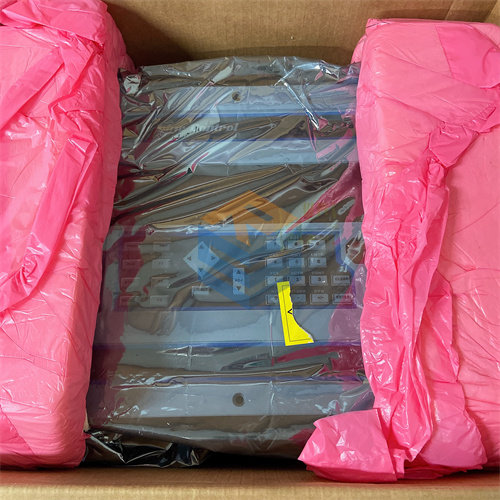

 +86 15340683922
+86 15340683922 +86 15340683922
+86 15340683922